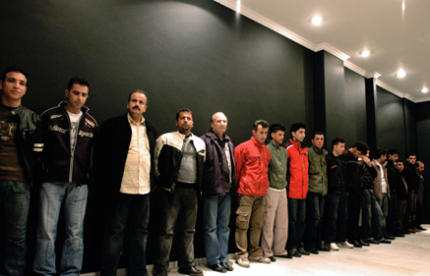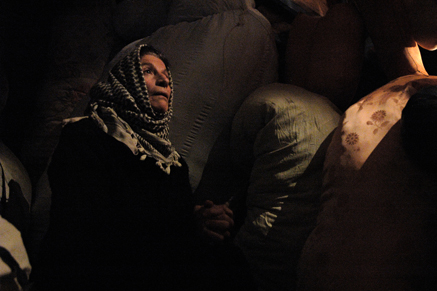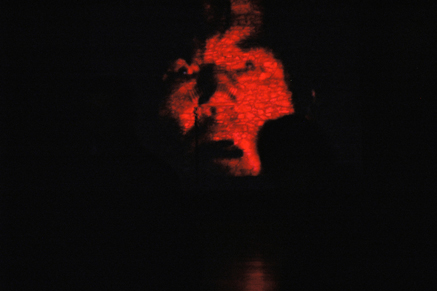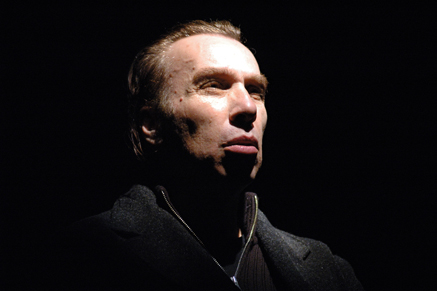In 2006 the famous Greek theatre director and founder of the Attis-Theatre (Athens) Theodoros Terzopoulos presented a short performance entitled Jenin (based on the poem of the same name by Etel Adnan). Terzopoulos staged the performance as a parcours that began in an Arabic coffee shop near his theatre and encompased the entire theatre space, including the foyer, the space beneath the seats, the stage itself, the rear exit, etc. The performance could best be described as a kind of silent dealing with the other that remains unincorporated. Drawing upon this experience, we talked about alterity, encounters and the power of the others.
NS: In Jenin, you worked on a scene in the foyer of the theatre with a group of illegal immigrants. I would like to hear a bit more about this special arrangement and the encounter of performers and spectators in this particular scene.
TT: I worked with 20 immigrants from North Iraq – the youngest was 18, the oldest 35 years old; he was the one who in the end convinced the others to participate; he was an excellent craftsman, I think he is in Sweden now. All of them shared unspeakable traumatic experiences in their homeland, as they were targeted both by Saddam Hussein and the Americans.
It was, in fact, I who went to them, full of hope and with high expectations: I wanted them to speak to me, to tell me their stories, to sing me their songs, to share their autobiographies with me. But none of those things happened, instead I was faced with a great silence which triggered my own silence.
So the scene we produced, became a silent halt/stance, a picture of silence: the performers were standing wordlessly one next to the other in front of the left wall of the foyer, while the small group of spectators gradually walked over to the wall on the opposite side and stood there. The situation provoked a feeling of fright and awe, similar to the effects of ancient Greek tragedy at its best.
I am convinced that we should return to silence and use it as the basis of every encounter. We should renounce the hegemonic position of the Western verbalist and merely listen.
NS: To what extent you would say that your theatre fosters an encounter with the other? What kind of forms does this encounter take or what kind of a content does it have?
TT: The encounter with the other, the foreign or the foreigner, is always an encounter of spaces: The primary space is the space of the other, my space follows and falls within this primary space. I am the one who needs to learn from the other, the other has nothing more to learn from me.
The encounter occurs at the level of raising awareness for a small scale: what is important are the small gestures, the undertones, the silences. With the onset of the last crisis in Europe – a crisis that is not just economic, but deeply cultural, psychological and ethical – big scales and big gestures have become defunct once and for all.
NS: The IRC uses the term interweaving to describe the process of the interaction of cultures. What kind of interweaving processes have you participated in as an artist?
TT: By speaking about the encounter of spaces, I do not mean the creation of a common utopian space. I am rather focusing on the encounter with the other, in whom I recognize myself. I do not enter the encounter with the intention of putting my tradition, my knowledge and my culture first, but I first of all want to know, listen, and learn from that other. And this does not necessary imply a face-to-face meeting; a piece of news or a picture can also be deeply touching. My picture is that of a woman, who upon hearing the news of her son’s death in Iraq tore apart the very symbol of her religion, her chador. This happened here, at Metaxourgio, close to our theatre. This picture may or may not activate memories and experiences, but the most important is that it can affect you.
Those Western European imperialists who made Latin America or South-Eastern Asia vanish have disappeared once and for all. Now it is the foreigner alone who owns the gaze, she is the one from whom I have to learn.
NS: Slavoj Žižek, for instance, criticizes the absence of the political or class dimension from the current discussion on interculturalism. How do you perceive the political in the encounter with the other?
TT: In today’s Europe, foreigners and locals both experience the same disablement, the same weakness, when they come into contact with the structures of power. The middle-class is vanishing and being replaced by a vast lumpen class – it remains to be seen if we can really talk of proletarians – which is not necessaraly a mass. Now, if this class manages to become a common body, it may be the only answer to exploitation. Political awareness – which will have nothing to do with ethnicity, but will attain a universality of its own – will then arise from this collective body.
NS: Do you think that theatre can play a part in this process?
TT: Theatre must once again become a call to the people, a demonstration in order to get things moving. Yes, I think theatre has this potential; this is its essence, after all.
–
—
All photos © Johanna Weber
Project curator: Maria Maragkou
Participating artists: Popi Krouska, Maria Loizidou, Despina Meimaroglou






